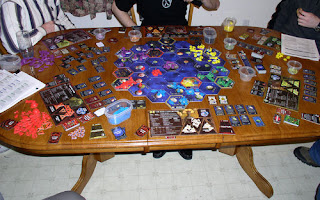Sticking to the theme of board games that I started with my recent short article on Twilight Imperium, I thought I would give my second most favorite board game a moment in the spot light as it certainly deserves it. Shogun, a game designed and released in the mid 80's, during what many might consider the golden age of big box board games, was my clear and undisputed favorite board game until the release of Twilight Imperium. A fairly simple game of strategic warfare with some tactical elements, a bit of diplomacy and management based on medieval Japan during the period of civil war in which Japanese Daimyos fought over the right to rule Japan. The design itself probably wouldn't stand out to most today in comparison to some of the great war games designed since then, in fact by most accounts the big board games of the 80's are classic for nostalgia sake rather then the fact that they were well designed games in themselves, but if there is one game that I think stood out and is still very playable and attractive today it would be Shogun.

The Classic 1985 release from Milton Bradly

A lot can be said about a game that is not just well designed, but nicely represented through the use of high quality art and pieces.
Shogun used a unique system, at the time, of having off board army formations represented by flags on the board, each player had three of these armies and created his army formation from several types of unique units like archers, gunners and samurai. Each unit had its own specialty and draw back, which meant that in order to be successful in combat you needed to have good positioning and good timing, as well as a bit of luck with the dice. The map itself was also very well balanced and the starting positions were randomized in much the same way as games like RISK which meant each game would have its own unique positioning and placement. Other interesting designs like the use of 'Ronin' warriors which would be purchased and placed face down on a territory card and revealed only when they were activated in combat gave players an opportunity to make unexpected surprise attacks giving the game a lot of very highly anticipated moments. The game played very well with 3, 4, or 5 players and because each player represented his own faction sort of speak, there was a lot of diplomatic maneuvering involved in securing temporary alliance, non aggression packs but at its heart it was a war game and each round boiled down to a fight.
One of my absolute favorite aspects of Shogun is that it was a very easy game to teach as its mechanics were incredibly simple and the strategic aspects of that mechanic were very apparent, despite actually being a very deep game. It was one of those, easy to learn, difficult to master type games. In fact I was originally introduced to the game when I was only 12 years old by my older brother and I had great success (although I never actually won) with players five years older then me. It's beautifully illustrated with lots of great, attractive pieces, speaking of it now I feel a sudden urge to play it. Fortunately unlike many big box games of the mid 80's that vanished into obscurity, this one was actually re-released in the mid 90's under the title Samurai Swords and although out of print now is still fairly easy to get from online resellers like eBay for a reasonable price (Usually around 50-70 dollars).
 Fortunatly when it was released in 1995 the only thing that was changed was the title, in fact they didn't even bother changing the title in the rulebook which reads Shogun even in this version.
Fortunatly when it was released in 1995 the only thing that was changed was the title, in fact they didn't even bother changing the title in the rulebook which reads Shogun even in this version.
If you ever get the chance, this is an absolute must have for anyone who considers himself a board gamer, especially if you have interest in war games. Put this one high on your list, as it is on mine.

 The Original 1st edition
The Original 1st edition
